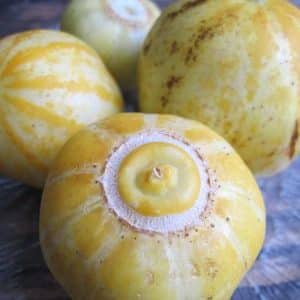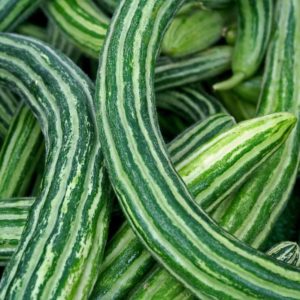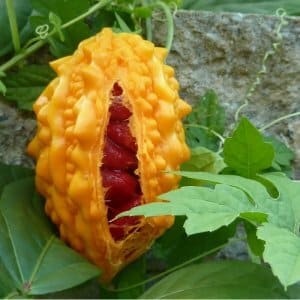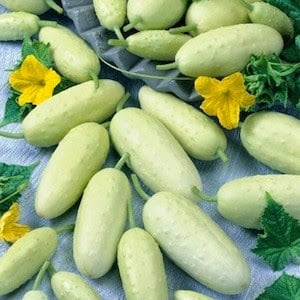Round cucumbers and other exotic varieties
Cucumber is a traditional crop grown by many summer residents. Breeders have developed a large number of varieties that differ in size, color and shape from the usual green vegetable.
What kind of variety is this - round cucumbers, their features, photos, what other unusual varieties exist - you will find out further.
What are round cucumbers and what are their features?
Round cucumbers are a variety of the common cucumber, the fruits of which are small in size, round in shape and have a white, greenish or yellowish peel.
Growing round cucumbers is no different from the agricultural techniques of familiar green vegetables:
- suitable for growing in open ground and greenhouses;
- need support.
Care consists of timely watering, weeding and regular application of mineral fertilizers.
Varieties and hybrids of round cucumbers
Breeders have bred several dozen hybrids that are striking in their fruit shape and unusual taste.
Chupa-chups/Lollipop F1
Culture developed by Russian specialists and is successfully grown in the Central, North-Western and Northern regions. Cucumber produces a good harvest in a greenhouse and under film cover.
The fruits are small in size, weighing 40-80 g, covered with a dark green peel with light stripes. The taste is delicate, pleasant, without bitterness. Resistant to cladosporiosis.
Melotria rough

This plant is called "round cucumber" or "mini cucumber". This is an annual vine native to South Africa.
Milotria fruits look like miniature watermelons, but have the familiar taste of cucumber.
In vegetable gardens, the vegetable is grown as seedlings. The first harvest is harvested 18-20 days after young plants are planted in the garden.
Many gardeners grow Milotria rough as an ornamental plant, as its beautiful dark green leaves retain their rich color until late autumn.
Citron/cucumber-lemon
This variety was bred by English breeders. Lemon cucumber is popular in Western Europe and the USA. Its fruits in the ripening phase have a soft light green color. When fully ripe, they become yellow in color and their shape resembles a citrus. The peel is thin, covered with small fluffs.
 The pulp contains a large amount of moisture, the taste is familiar to cucumbers, without acid. Lemon cucumber bears fruit before the onset of autumn frosts. During the growing season, the plant requires a large amount of light and moisture.
The pulp contains a large amount of moisture, the taste is familiar to cucumbers, without acid. Lemon cucumber bears fruit before the onset of autumn frosts. During the growing season, the plant requires a large amount of light and moisture.
In open ground, the variety is grown through seedlings. Since the length of the vine can reach 5-7 m, it is attached to trellises or mesh.
The distance between sprouts during planting should not be less than 1 m. With thickened plantings, the yield decreases.
The fruits are used for food in fresh and canned form.
Important! Lemon cucumber can be grown in an apartment. To get a harvest at home, the plant is pollinated with a brush.
Other unusual types of cucumbers
In their gardens, experimenters grow many types of exotic cucumbers that have an unusual shape. Most of them are adapted for planting in various climatic conditions and are not demanding in terms of maintenance conditions.
Armenian
The plant was brought from Central Asia. The most popular varieties are White Bogatyr and Silver Melon.The crop is grown in beds, greenhouses and greenhouses.
 The fruit of the Armenian cucumber is long, up to 50 cm, and has a slight silvery pubescence. The pulp is tender, slightly sweet, reminiscent of pumpkin or melon.
The fruit of the Armenian cucumber is long, up to 50 cm, and has a slight silvery pubescence. The pulp is tender, slightly sweet, reminiscent of pumpkin or melon.
The length of the stems can reach 4-5 m, so the plant needs support. When placed on trellises or nets, the yield of Armenian cucumber increases significantly. The fruits receive more light, acquire the correct shape, ripen faster and are not affected by rot.
With proper cultivation, up to 25 kg of cucumbers can be harvested from one bush during the season. The variety has a long fruiting period, is resistant to diseases and pests, and tolerates high and low temperatures and lack of moisture.
Momordica
The plant is very popular in India. U momords there are other names: “Indian cucumber”, “Indian pomegranate”, “balsamic pear”, “crazy melon”, “crocodile cucumber”. About 12 varieties of this crop are known.
It is believed that eating momordica has a beneficial effect on the body and prolongs life.
 The plant is a vine with shoots up to 2 m long. Momordica leaves are carved and dark green in color. The flowers have a delicate scent reminiscent of jasmine.
The plant is a vine with shoots up to 2 m long. Momordica leaves are carved and dark green in color. The flowers have a delicate scent reminiscent of jasmine.
The fruits are elongated or slightly elongated, covered on the outside with a dense, lumpy, dark green peel that has a bitter aftertaste.. As they ripen, the shape and color of the fruit change. The skin takes on a bright orange or lemon hue.
The fruits gradually open and become like the mouth of a crocodile, inside of which you can see dense jelly-like pulp with the taste of ripe persimmon or pumpkin and raspberry seeds. During the season, one momordica bush produces up to 10 kg of fruit.
Interesting. Momordica is often used to decorate personal plots, planted along the fence or near gazebos, on balconies and loggias.
The plant is easy to care for and its cultivation does not cause any particular difficulties. The seeds have a hard shell, so before planting they are rubbed with sandpaper and then disinfected in a weak solution of potassium permanganate.
Seeds are germinated at a temperature of +25°C, wrapped in a damp cloth. After the seed shell cracks, it is planted in moist soil.
At the end of May, the seedlings are moved into open ground. After transplantation, young shoots are regularly watered and fed with mineral fertilizers or yeast solution.
When growing momordica at home, plants are pollinated: pollen is transferred from one flower to another using a brush. Plants need vertical support, which will ensure normal shoot growth and access of air and sunlight to the fruits.
Surprise
Cucumber Surprise F1 is a hybrid intended for cultivation in greenhouses and greenhouses. The crop is planted in the Northern, Northwestern and Central regions.
An adult plant has stems up to 2.5 m long. The leaves are dissected, lobed, dark green. Zelentsy are triangular, elongated, with black or brown pubescence. The peel is tuberous, slightly wrinkled, thin, the flesh is tender. The taste of the fruit combines the pleasant freshness and sweetness of melon.
White cucumbers
White cucumbers They have an unusual appearance: the fruits have a white skin. Some varieties are distinguished by a greenish tint near the stalk.
Differences between white and green varieties:
- the peel is thin and tender;

- there is no bitterness;
- the taste is rich and bright;
- fruits are set along the entire length of the stem;
- the fruits are clearly visible in the dense, bright green foliage.
Cucumbers are planted in beds located in the shade. The varieties are characterized by high yield, good shelf life and transportability.
The crop grows well in any climatic conditions, is resistant to diseases and pests, and easily tolerates temperature changes, lack or excess of moisture. Even a novice gardener can cope with its cultivation.
White angel
High-yielding early ripening variety with medium-sized fruits, white in color and small thorns. The fruits have a fresh taste without bitterness. The weight of one cucumber does not exceed 70-80 g. The yield is up to 4 kg per bush. Used for fresh consumption and winter storage.
Bride
An early ripening hybrid, the harvest ripens 40 days after planting. This is a tall plant with long shoots. The fruits are small, have tender pulp with a sweetish taste. The crop requires regular fertilizing and frequent watering, so it can be difficult to grow a high yield.
White crunch
The hybrid is grown indoors. The first harvest is harvested 45 days after planting. The fruits are up to 15-17 cm long, covered with a smooth skin, without thorns, and white. Friendly ripening, cucumber weight 170-200 g.
Trichosanth

This representative of the Pumpkin family is otherwise called “snake cucumber”. It is grown in Southeast Asia, India and Australia as a vegetable crop. In Russia it is famous among lovers of exotic plants. Trichozant is distinguished not only by its unusual appearance, but also by its ease of care. The plant is grown in greenhouses as seedlings.
Trichosanth flowers are large, up to 4 cm in diameter, reminiscent of symmetrical snowflakes.The cylindrical fruits reach a length of 1 m. As they grow, they bend and resemble writhing snakes. The color of the fruit changes over time from light green to rich red-orange.
They taste like regular cucumbers. A tonic drink is prepared from the fruits of trichosanth. They are used in folk medicine to treat heart and vascular diseases, arthritis and osteochondrosis.
Tladianta doubtful
Under natural conditions it grows in Southeast Asia, in meadows and among shrubs.
Tladiantu grown as an ornamental, medicinal, and food crop.
This is a perennial creeping vine up to 5 m long with highly branched shoots covered with short villi. The leaves are large, soft, oval in shape. The flowers are dioecious, small, collected in inflorescences of 10 pieces, painted yellow. The fruits are medium in size and shaped like regular cucumbers.
The peel is red in color with a sweetish taste of pineapple or kiwi. They are eaten fresh or canned. Tubers have choleretic, diuretic and lactogonic properties.
Medicines are prepared from the roots to treat diabetes, joint pain, and hypertension.
Conclusion
Most exotic cucumbers are imported from the tropics. They quickly adapted to the new climatic conditions of Russia and produce a good harvest. Some species are bred by breeders.
These plants differ from their green counterparts in their unusual shape and taste. They are easy to care for and are used to prepare various dishes and treat diseases.